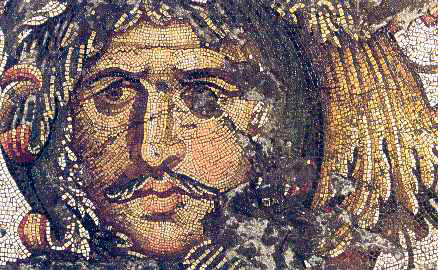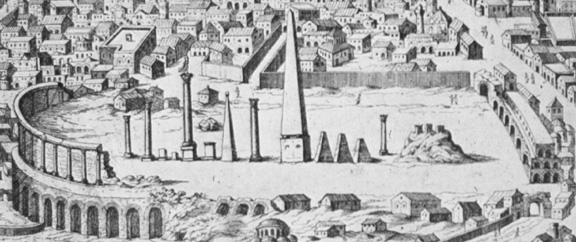|
Covered Hippodrome
The Covered Hippodrome ( el, ) was a covered courtyard that served as an antechamber to the Great Palace of Constantinople in Istanbul, Turkey. The French scholar Rodolphe Guilland also equated it with the emperors' private hippodrome. It lay on the southeastern corner of the palace complex, and connected the Palace of Daphne in the north with the later lower palace complex around Bucoleon in the south, through the gate of Skyla. It played a great role in imperial ceremonies, and is not to be confused with the far larger adjacent Hippodrome of Constantinople, which in Byzantine sources was often distinguished as the "uncovered" () Hippodrome. From the 9th to the 11th centuries, it was also the site of one of the Byzantine capital's highest courts, the tribunals of the "judges of the Hippodrome" () and of the "judges of the ''velum Velum may refer to: Human anatomy * Superior medullary velum, anterior medullary velum or valve of Vieussens, white matter, in the brain, which stretc ... [...More Info...] [...Related Items...] OR: [Wikipedia] [Google] [Baidu] |
Constantinople Imperial District
la, Constantinopolis ota, قسطنطينيه , alternate_name = Byzantion (earlier Greek name), Nova Roma ("New Rome"), Miklagard/Miklagarth (Old Norse), Tsargrad (Slavs, Slavic), Qustantiniya (Arabic), Basileuousa ("Queen of Cities"), Megalopolis ("the Great City"), Πόλις ("the City"), Kostantiniyye or Konstantinopolis (Turkish language, Turkish) , image = Byzantine Constantinople-en.png , alt = , caption = Map of Constantinople in the Byzantine period, corresponding to the modern-day Fatih district of Istanbul , map_type = Istanbul#Turkey Marmara#Turkey , map_alt = A map of Byzantine Istanbul. , map_size = 275 , map_caption = Constantinople was founded on the former site of the Greek colonisation, Greek colony of Byzantion, which today is known as Istanbul in Turkey. , coordinates = , location = Fatih, İstanbul, Turkey , region = Marmara Region , type = Imperial city , part_of ... [...More Info...] [...Related Items...] OR: [Wikipedia] [Google] [Baidu] |
Great Palace Of Constantinople
The Great Palace of Constantinople ( el, Μέγα Παλάτιον, ''Méga Palátion''; Latin: ''Palatium Magnum''), also known as the Sacred Palace ( el, Ἱερὸν Παλάτιον, ''Hieròn Palátion''; Latin: ''Sacrum Palatium''), was the large imperial Byzantine palace complex located in the south-eastern end of the peninsula now known as Old Istanbul (formerly Constantinople), in modern Turkey. It served as the main imperial residence of the Eastern Roman or Byzantine emperors until 1081 and was the centre of imperial administration for over 690 years. Only a few remnants and fragments of its foundations have survived into the present day. History When Constantine I refounded Byzantium as Constantinople in 330, he planned out a palace for himself. The palace was located between the Hippodrome and Hagia Sophia. The complex of palaces was rebuilt and expanded several times during its history. Much of the complex was destroyed during the Nika riots of 532 and was rebuil ... [...More Info...] [...Related Items...] OR: [Wikipedia] [Google] [Baidu] |
Istanbul, Turkey
Istanbul ( , ; tr, İstanbul ), formerly known as Constantinople ( grc-gre, Κωνσταντινούπολις; la, Constantinopolis), is the List of largest cities and towns in Turkey, largest city in Turkey, serving as the country's economic, cultural and historic hub. The city straddles the Bosporus strait, lying in both Europe and Asia, and has a population of over 15 million residents, comprising 19% of the population of Turkey. Istanbul is the list of European cities by population within city limits, most populous European city, and the world's List of largest cities, 15th-largest city. The city was founded as Byzantium ( grc-gre, Βυζάντιον, ) in the 7th century BCE by Ancient Greece, Greek settlers from Megara. In 330 CE, the Roman emperor Constantine the Great made it his imperial capital, renaming it first as New Rome ( grc-gre, Νέα Ῥώμη, ; la, Nova Roma) and then as Constantinople () after himself. The city grew in size and influence, eventually becom ... [...More Info...] [...Related Items...] OR: [Wikipedia] [Google] [Baidu] |
Rodolphe Guilland
Rodolphe Joseph Guilland (Lons-le-Saunier, 1888 – Saint-Marcellin, Isère, 5 October 1981) was a French Byzantinist. Life Born in 1888, he completed his thesis on Nikephoros Gregoras (a biography in 1926, and his edited correspondence in 1927), and succeeded his teacher Charles Diehl in the seat of Byzantine studies at the Sorbonne in 1934, which he held until his retirement in 1958. His chief interest was in the late Byzantine period (1204–1453), particularly the Palaiologan period, and his main areas of research were the history of the Great Palace of Constantinople The Great Palace of Constantinople ( el, Μέγα Παλάτιον, ''Méga Palátion''; Latin: ''Palatium Magnum''), also known as the Sacred Palace ( el, Ἱερὸν Παλάτιον, ''Hieròn Palátion''; Latin: ''Sacrum Palatium''), was th ..., and of the offices, dignities, and administrative apparatus of the Byzantine state. Works He wrote 192 works on Byzantine subjects, spanning the years from 1921 to ... [...More Info...] [...Related Items...] OR: [Wikipedia] [Google] [Baidu] |
Palace Of Daphne
The Palace of Daphne ( el, Δάφνη) was one of the major wings of the Great Palace of Constantinople, the capital of the Byzantine Empire (modern Istanbul, Turkey). According to George Codinus, it was named after a statue of the nymph Daphne, brought from Rome. The exact layout and appearance of the palace is unclear, since it lies under the Sultan Ahmed Mosque, and the only surviving evidence comes from literary sources.Westbrook (2007) Jonathan Bardill, however, has suggested that the peristyle with mosaics adjoining an apsed hall, excavated by the Walker Trust excavations in 1935-7 and 1952-4, could be the Augusteus of the Daphne Palace. History and description The Daphne belonged to the earliest building phase of the palace complex, that of Constantine I, who rebuilt the city of Byzantium into Constantinople, his new capital, as well as his immediate successors. Justin II () expanded the original building, which remained the main residential area for the emperors until th ... [...More Info...] [...Related Items...] OR: [Wikipedia] [Google] [Baidu] |
Bucoleon
The Palace of Boukoleon ( el, Βουκολέων) or Bucoleon was one of the Byzantine palaces in Constantinople (present-day Istanbul in Turkey.) The palace is located on the shore of the Sea of Marmara, to the south of the Hippodrome and east of the Little Hagia Sophia. Names Hormisdas is an earlier name of the place. The name Bucoleon was probably attributed after the end of the 6th century under Justinian I, when the small harbour in front of the palace, which is now filled, was constructed. According to tradition, a statue featuring a bull and a lion stood there, giving the port its name (βοῦς and λέων are Greek for "bull" and "lion" respectively). The palace is accordingly also called the "House of Hormisdas" and "House of Justinian". History Boukoleon palace was probably built during the reign of Theodosius II in the 5th century. Emperor Theophilos rebuilt and expanded the palace, adding a large façade on top of the seaward walls and in 969 Emperor Nikepho ... [...More Info...] [...Related Items...] OR: [Wikipedia] [Google] [Baidu] |
Hippodrome Of Constantinople
Sultanahmet Square ( tr, Sultanahmet Meydanı) or the Hippodrome of Constantinople ( el, Ἱππόδρομος τῆς Κωνσταντινουπόλεως, Hippódromos tēs Kōnstantinoupóleōs; la, Circus Maximus Constantinopolitanus; tr, Hipodrom) is a square in Istanbul, Turkey. Previously, it was a circus that was the sporting and social centre of Constantinople, capital of the Byzantine Empire. The word ''hippodrome'' comes from the Greek ''hippos'' (), horse, and ''dromos'' (δρόμος), path or way. For this reason, it is sometimes also called ("Horse Square") in Turkish. Horse racing and chariot racing were popular pastimes in the ancient world and hippodromes were common features of Greek cities in the Hellenistic, Roman and Byzantine eras. History and use Construction Although the Hippodrome is usually associated with Constantinople's days of glory as an imperial capital, it actually predates that era. The first Hippodrome was built when the city was ... [...More Info...] [...Related Items...] OR: [Wikipedia] [Google] [Baidu] |
Byzantine
The Byzantine Empire, also referred to as the Eastern Roman Empire or Byzantium, was the continuation of the Roman Empire primarily in its eastern provinces during Late Antiquity and the Middle Ages, when its capital city was Constantinople. It survived the fragmentation and fall of the Western Roman Empire in the 5th century AD and continued to exist for an additional thousand years until the fall of Constantinople to the Ottoman Empire in 1453. During most of its existence, the empire remained the most powerful economic, cultural, and military force in Europe. The terms "Byzantine Empire" and "Eastern Roman Empire" were coined after the end of the realm; its citizens continued to refer to their empire as the Roman Empire, and to themselves as Romans—a term which Greeks continued to use for themselves into Ottoman times. Although the Roman state continued and its traditions were maintained, modern historians prefer to differentiate the Byzantine Empire from Ancient Rome a ... [...More Info...] [...Related Items...] OR: [Wikipedia] [Google] [Baidu] |
Velum (Byzantium)
Velum may refer to: Human anatomy * Superior medullary velum, anterior medullary velum or valve of Vieussens, white matter, in the brain, which stretches between the superior cerebellar peduncles ** Frenulum of superior medullary velum, a slightly raised white band passing to the superior medullary velum * Inferior medullary velum or posterior medullary velum, a thin layer of white substance, prolonged from the white center of the cerebellum * Velum interpositum or choroid plexus, a structure in the brain where cerebrospinal fluid is produced ** Cavum veli interpositi, a condition in which the cistern of the velum interpositum becomes dilated * Palatal velum or soft palate, the soft tissue constituting the back of the roof of the mouth ** Levator velum palatini muscle or levator veli palatini, the elevator muscle of the soft palate Nature * Velum (botany), a morphological feature of quillworts or ''Isoëtes'' * Cumulonimbus velum, a cloud type * ''Solemya velum'', or Atlantic ... [...More Info...] [...Related Items...] OR: [Wikipedia] [Google] [Baidu] |



